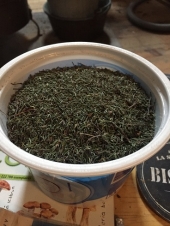Greg,
Although most of our land is just gently sloping, I have a little escarpement towards the top of my tree field which is pretty steep, probably 1 in 1. I only plant woodland trees in this bit and have generally left them to their own devices. As you've also found, extreme gardening is a little tricky. I did have some little junipers, which I wanted to tuck in a bit more carefully and what I did I have since regretted. We had some lovely carpet underlay made mostly from jute shoddy, like a thick felt, which I couldn't resist using. Cut with a slit in for the trees to poke through jit was quite effective and pretty long lasting.

The problem with the underlay was the bit that wasn't jute....through the felt there was a mesh of thermoplastic, probably polythene, I'd hoped that I'd be able to fish this out of a beautifully cleared spot as the underlay degraded, but this wasn't to be.

The grasses grew over and through the felt so that the plastic net was hopelessly entangled. I tried mulching over the top with cardboard hut had limited success so I've had hell's delight getting it back out again. However the material apart from that was excellent.
Most of the sheet materials I think of that would work would be rather expensive at any scale (natural woven carpet and matting, really thick papier mache made from biomaterials). The best suggestion I have is to use bigger twiggy materials that will support each other and living mulches that will build up in situ like bracken and comfrey.
Watching....








